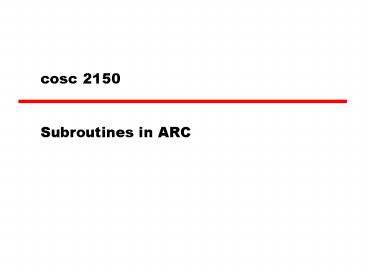cosc 2150 - PowerPoint PPT Presentation
1 / 10
Title: cosc 2150
1
cosc 2150
- Subroutines in ARC
2
Assembly code
- There are two instructions used for subroutine
calls - call label
- This will change the PC to where the labels
address and put the current address into r15 - jmpl rX4, rY
- will jump to the address rX and put the current
address in rY - Normally rX is r15, the 4 is because you would
return the call instruction, instead of the next
instruction.
3
example
- . (instructions)
- call sub_r ! call subroutine sub_r
- sub r2, 2,r1
- . (more instructions)
- halt
- sub_r addcc r1, 2, r2
- jmpl r154, r0 !go back to sub instruction
4
Code style
- Subroutines are written so that you execute a
piece of code and then return back. - You can not branch out of a subroutine back to
the "main" code. - You subroutines are not be "inside" the main code
either. - The jmpl command, places the address of the
instruction in r15. Because we do not have a
stack for the emulator, you MUST store this
value. - The reason will shown in example 2.
5
Example 1
- main ()
- int a 2
- a a 3
- sub_r()
- void sub_r()
- a a 1
- .begin
- .org 2048
- ! main ld a,r1add r1,3, r1st r1,
acall sub_r !call sub sub_rhalt - ! subroutine sub_r
- sub_r st r15, sub_r_l
- ld a,r1add r1,1,r1st r1, a
- ld sub_r_l, r15jmpl r154,r5
- sub_r_l 0
- a2
- .end
6
Example 2
- main ()
- int a2
- sub1()
- sub2()
- sub1()
- sub1 ()
- a a 1
- sub2()
- sub2 ()
- a a 2
- .begin
- .org 2048
- ld a, r1 !load A into r1call sub1 !call
sub sub1call sub2 !call sub sub2 - call sub1 !call sub sub1halt
- sub1 st r15, sub1_ladd r1, 1, r1st r1,
acall sub2ld sub1_l, r15jmpl r154, r2 - sub2 st r15, sub2_ladd r1, 2, r1st r1,
ald sub2_l, r15jmpl r154, r2 - sub2_l 0
- sub1_l 0
- a 2
- .end
7
Recursion
- Is recursion possible in ARC code?
- No
- A new subroutine would have to created for each
instance of the recursion and ARC code does not
have that possibility. - because we have store register 15, which would
over write the old value.
8
Example 3
- main ()
- int a1, b 2
- a a b
- sub1()
- b b a
- sub1 ()
- a b 1
- b a 2
- .begin
- .org 2048
- ! main ld a, r1ld b, r2add r1,r2,
r1st r1, acall sub1 !call subroutine
sub1add r1, r2, r2 - st r2, b
- halt
- ! subroutine sub1
- sub1 st r15, sub1_lsub r2,1,r1st r1,
aadd r1, 2, r2st r2, bld sub1_l,
r15jmpl r154,r5 - sub1_l 0
- a 1
- b 2
- .end
9
Example 4
- main()
- int a3, i
- for (i0 ilt3 i)
- if (i gt0)
- sub1()
- else
- ai i 1
- sub1 ()
- ai i - 1
- .begin
- .org 2048
- ld i, r1
- top subcc r1, 3, r0 ! ilt3
- bpos done
- !if (igt0)
- subcc r1, 1, r0
- bneg else
- call sub1
- ba incr
- else sll r1, 2, r2 !ai i -1
- addcc r1, 1, r3
- st r3, r2a
- incr add r1, 1, r1 !i
- ba top
- st r1, i
- done halt
- sub1 st r15, sub1_l
10
Q
A































